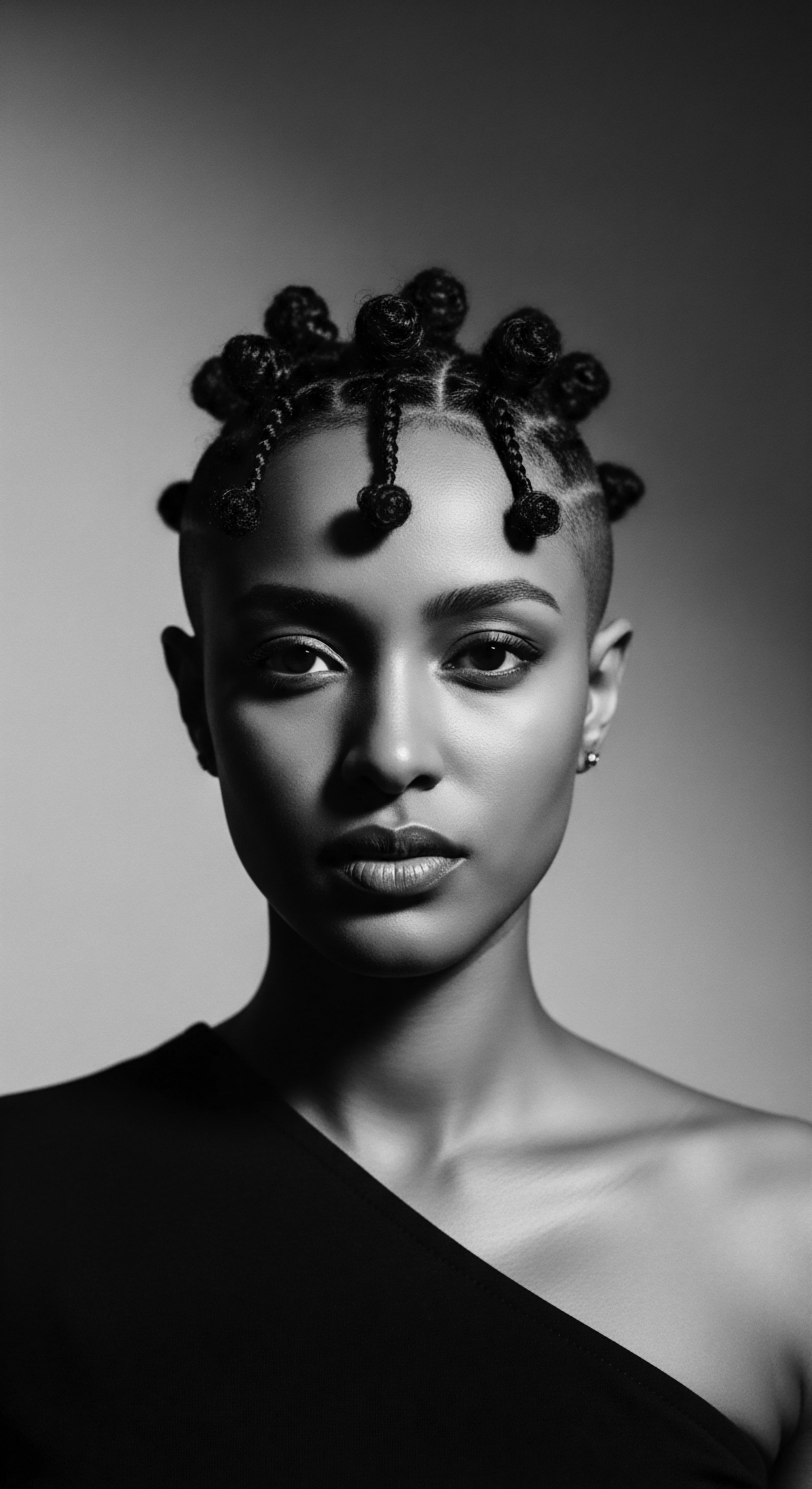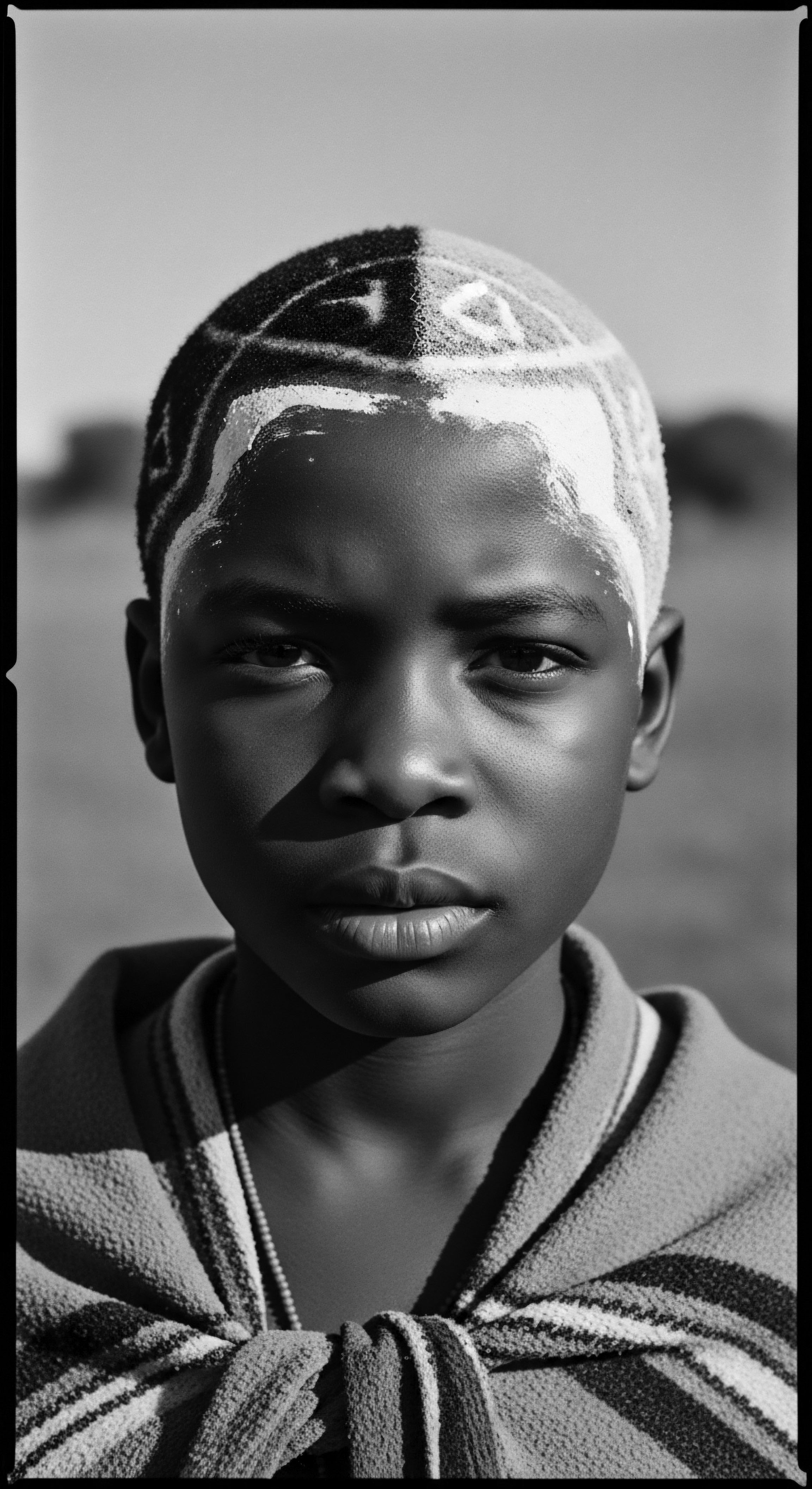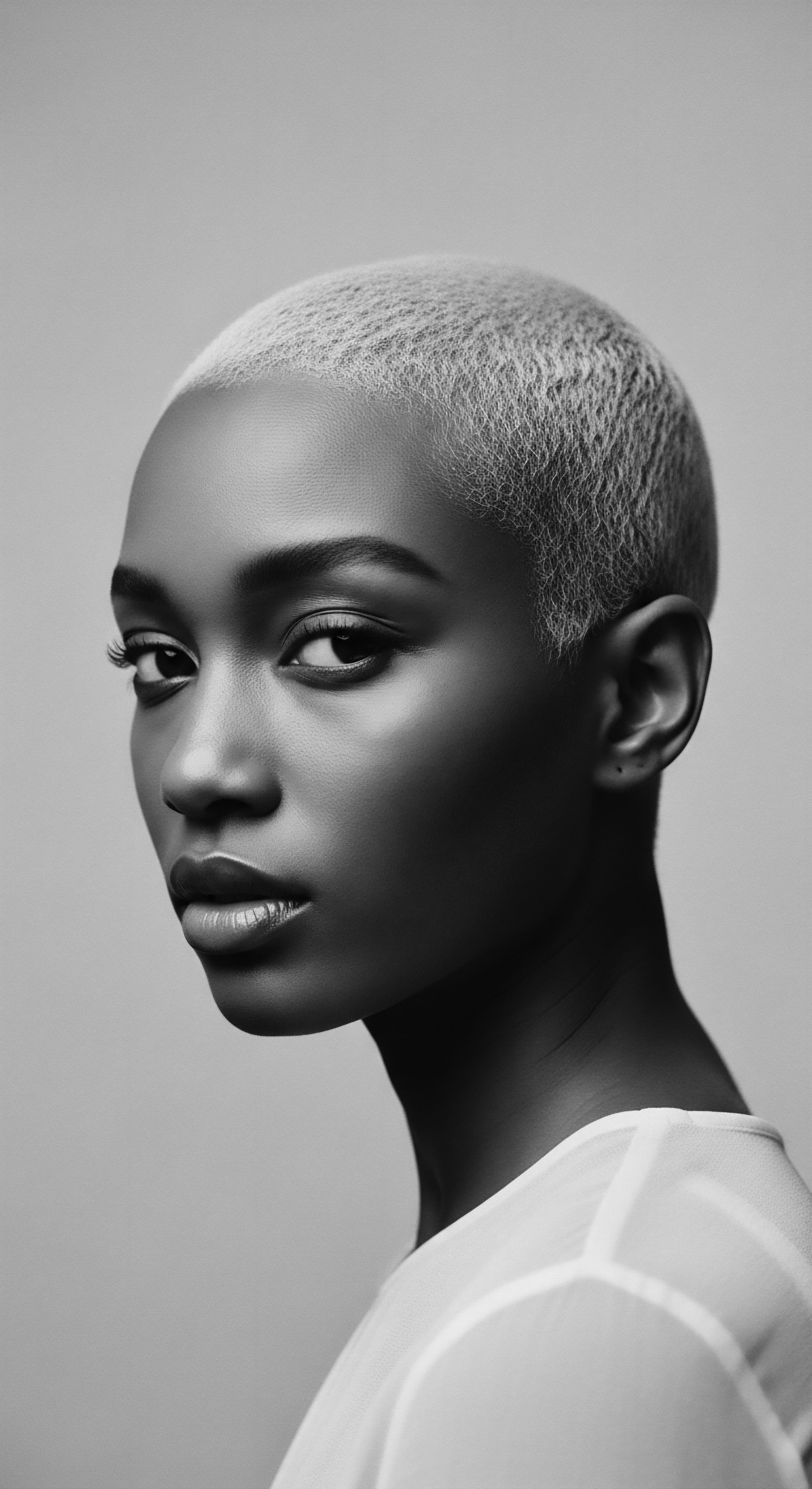
Roots
To truly understand the ancestral spirit woven into every strand of textured hair, we must first turn our gaze to the sun-drenched landscapes of pre-colonial Africa. Here, amidst vibrant cultures and ancient wisdom, hair was far more than mere adornment. It served as a profound communicator, a living parchment upon which stories of belonging, status, and spiritual connection were inscribed.
The oils used in these sacred grooming practices were not simply conditioners; they were conduits, drawing earthly abundance to nourish the crown, linking the individual to their lineage and the cosmic dance. These precious elixirs, extracted with reverence from indigenous plants, tell a tale of intimate kinship with the land, a shared heritage stretching back millennia.

What Did Hair Oils Represent in Pre-Colonial African Societies?
Across the diverse societies of pre-colonial Africa, hair oils were an integral component of grooming rituals that expressed identity. Hairstyles themselves acted as visual encyclopedias, signaling a person’s Geographic Origin, their Marital Status, their age, their ethnic identity, their religion, their wealth, and their societal rank. The application of oils was intrinsically linked to maintaining these intricate styles and, by extension, the messages they conveyed. For instance, among the Yoruba people of Nigeria, hair was considered the body’s most elevated point, holding spiritual power, and braided hair could transmit messages to the divine.
Oiling the hair would have been a fundamental step in preparing the hair for such intricate, meaningful expressions, ensuring its health and pliability. This care ritual was not just a utilitarian act but a communal activity, a time for bonding and shared wisdom.

How Did Ancient Practices Shape Hair Health and Appearance?
The textured hair we celebrate today, with its unique coil patterns and inherent strength, found its natural ally in the plant life of the continent. Ancient African civilizations did not just style hair; they nurtured it, understanding its biological needs long before modern science articulated them. The oils and butters they carefully processed were rich in compounds that provided deep hydration, fortification, and protection against environmental factors. Consider the shea butter (Vitellaria paradoxa), a staple across the Sudano-Sahelian region of West and East Africa.
For centuries, women have managed shea trees and processed their kernels into this nourishing butter, which was not only a food source but also a beauty aid. This vegetable fat was indispensable in semi-arid environments where other oil-producing plants, like the oil palm, did not flourish. It was collected and processed by rural women, a significant source of income, often referred to as “women’s gold.”
Hair oils in pre-colonial Africa were not just cosmetic; they were deeply embedded cultural tools, speaking volumes about identity and spiritual connection.
The practice of oiling also played a role in maintaining the hair’s integrity against the elements. The dry climates in many parts of Africa necessitated moisture retention, and these plant-derived lipids provided a natural barrier. In ancient Egypt, for example, people used various oils and animal fats to protect their skin and hair from the harsh sun and dry wind.
Even mummification practices show how important hair care was ❉ fatty materials, akin to modern hair gels, were applied to preserve hairstyles, ensuring the deceased’s individuality persisted into the afterlife. This highlights a profound understanding of hair’s structural needs and its enduring symbolic value.
The knowledge of these natural ingredients and their benefits was passed down through generations, forming an unbroken chain of ancestral wisdom. It was a testament to observation, experimentation, and a symbiotic relationship with the earth. The very act of extracting these oils – whether pressing seeds or churning butters – became a part of the communal fabric, linking hands and hearts in a shared cultural rhythm.

Ritual
The rituals surrounding hair care in pre-colonial Africa extended far beyond simple grooming; they were elaborate ceremonies, social gatherings, and expressions of communal cohesion. The application of hair oils was a central act within these traditions, transforming mundane upkeep into a sacred practice, reinforcing social structures, and transmitting cultural heritage across generations. These weren’t isolated moments but woven elements in the rich tapestry of daily life, public ceremony, and spiritual observance.

How Did Hair Oiling Rituals Solidify Social Standing?
The meticulous processes involved in hair oiling and styling were often time-consuming, sometimes requiring hours or even days. This investment of time and resources underscored the significance of hair in society. The resulting hairstyles, often adorned with elaborate decorations, were explicit markers of a person’s social standing. For instance, among some communities, the thickness, length, and neatness of a woman’s hair, carefully maintained with oils and styled into braids, could signify her ability to cultivate bountiful farms and bear healthy children.
Leaders and royalty across various African cultures often sported very elaborate hairstyles, sometimes incorporating headpieces or adornments that symbolized their stature. These styles, kept vibrant and supple with natural oils, visually communicated their authority and connection to the community’s well-being.
The communal nature of hair care, where women would gather to wash, comb, oil, and braid one another’s hair, also reinforced social bonds. These interactions were spaces for storytelling, for sharing wisdom about life, and for instructing younger generations in the ancestral practices of hair care. It was during these moments that the meanings behind specific styles, the properties of various oils, and the historical significance of their use would be imparted. Such communal activities reinforced identity within the group, making the process of caring for hair as important as the outcome itself.
Consider the practice among the Himba tribe in Namibia, who coat their dreadlocked styles with Red Ochre Paste (otjize). This paste, a blend of ochre, butterfat, and sometimes aromatic resin, protects the hair and skin from the sun and insects. It also symbolizes their connection to the earth and their ancestors. The act of applying this mixture is a daily ritual, a constant reaffirmation of identity and heritage.
While not a pure oil, the butterfat component functions similarly, providing nourishment and acting as a base for the culturally significant pigment. This deeply ingrained practice extends beyond aesthetics, becoming a living testament to their cultural values and ancestral lineage.
| Community/Region Yoruba (Nigeria) |
| Oil/Ingredient Highlight Various plant oils (e.g. palm oil, shea butter) |
| Identity Signified (Pre-Colonial Context) Spirituality, communication with deities, social status, age |
| Community/Region Himba (Namibia) |
| Oil/Ingredient Highlight Butterfat (mixed with ochre) |
| Identity Signified (Pre-Colonial Context) Connection to earth and ancestors, tribal affiliation, beauty standards |
| Community/Region Ancient Egypt |
| Oil/Ingredient Highlight Castor oil, olive oil, animal fats |
| Identity Signified (Pre-Colonial Context) Wealth, status, beauty, motherhood, fertility, individuality (even in death) |
| Community/Region San (Kalahari Desert) |
| Oil/Ingredient Highlight Kalahari Melon oil, Mongongo oil |
| Identity Signified (Pre-Colonial Context) Adaptation to environment, indigenous knowledge, resourcefulness |
| Community/Region These examples illustrate how natural oils played a role in expressing diverse identities across pre-colonial African societies. |

What are the Ancestral Ingredients That Supported Textured Hair Vitality?
The bounty of the African landscape offered a pharmacopoeia of natural ingredients perfectly suited for textured hair. Beyond shea butter, numerous other plant-derived oils and fats were used. For example, palm oil (Elaeis guineensis), a cornerstone in many West and Central African societies, was not only vital for food but also for personal care.
The black palm kernel oil, for instance, was considered an indispensable ingredient for skin and hair care, especially for newborns. It was celebrated as the “tree of life” in traditional songs, a testament to its multifaceted uses and deep cultural appreciation.
From the arid expanses of the Kalahari Desert, the San people utilized oils like Kalahari Melon oil and Mongongo oil . The Kalahari Melon (Citrullus lanatus), an important water source, provides an oil rich in phytosterols and Omega-6, valued for its moisturizing and restructuring properties. Mongongo oil, extracted from the seeds of the Mongongo tree, contains eleostearic acid, which forms a protective film over each hair, especially beneficial in dry, harsh conditions.
These oils speak to a profound ancestral knowledge of botany and a practical understanding of how to sustain hair health in challenging environments. Such ingenuity demonstrates a heritage of deep ecological wisdom, where survival and beauty were intertwined with the careful application of natural resources.
Hair care in pre-colonial Africa was a deeply social event, reinforcing community bonds and transmitting generations of knowledge through shared rituals.
The careful selection and application of these oils were not random acts but informed choices, reflecting a deep understanding of botanical properties. This ancestral wisdom formed the basis of holistic care regimens that prioritized both physical well-being and spiritual connection. The application of oils was often accompanied by specific chants, prayers, or communal songs, infusing the practice with additional layers of meaning. This holistic approach considered the individual’s hair a living part of themselves, connected to their lineage and their place in the world.

Relay
The enduring legacy of pre-colonial hair oil traditions echoes powerfully through contemporary textured hair care, demonstrating a continuous relay of ancestral wisdom across generations. Understanding these historical practices allows us to appreciate the scientific efficacy of ancient methods and their profound impact on Black and mixed-race identities. This section explores how these historical precedents contribute to our current understanding of textured hair health and cultural affirmation, drawing connections between past and present.

How Do Ancient Practices Align with Modern Hair Science?
The choices of oils in pre-colonial African societies, driven by empirical observation and inherited knowledge, often align remarkably with modern scientific understanding of hair biology. For instance, the widespread use of oils like shea butter and palm kernel oil provided significant benefits. Shea butter contains fatty acids and vitamins that are known to moisturize, protect, and soften hair, reducing breakage.
Its ability to penetrate the hair shaft offers substantial conditioning, a fact now supported by trichological studies. Palm kernel oil, with its unique composition, was used not just for skin and hair care but also in traditional medicine for various ailments, underscoring its broad therapeutic value.
Recent archaeological findings validate these ancestral practices. Research on ancient Egyptian mummies, for example, reveals that hair was treated with fatty materials containing palmitic and stearic acids, which are common in many plant-derived oils. This indicates an advanced understanding of hair preservation and styling, with a focus on retaining the hair’s structure and appearance even after death.
The intent was not simply cosmetic; it was to preserve individuality and identity, underscoring the deep cultural weight placed on hair. This historical example confirms that the use of oils was a sophisticated practice, tailored to specific needs and demonstrating an early form of cosmetic science.
The traditional uses of many African plants for hair care are now gaining recognition in ethnobotanical studies. For example, a review of African plants used for hair care lists 68 species, many of which have properties that address conditions like alopecia and dandruff. Some of these species, like Citrullus lanatus (Kalahari Melon), are even used in modern natural hair care products, bringing ancestral knowledge into contemporary practice and supporting local communities. The scientific validation of these ancient remedies offers a compelling testament to the wisdom embedded in historical hair care routines.
The ancestral practices were, in essence, a form of holistic wellness. They recognized that hair health is not isolated but connected to overall well-being. This perspective aligns with modern holistic hair care, which considers nutrition, environmental factors, and even emotional states as influencing hair vitality. The careful selection of oils for specific hair types or conditions, often based on their perceived ‘strength’ or ‘lightness,’ speaks to an intuitive, yet effective, empirical pharmacology that predates formalized scientific methods.

What is the Enduring Significance of Hair Oils in Black and Mixed-Race Heritage?
The resilience of textured hair heritage is palpable in the continued use of traditional oils and practices today, particularly within Black and mixed-race communities. Despite centuries of colonial attempts to strip African peoples of their identity, including forcing them to shave their heads and devaluing their natural hair, the knowledge of these oils and their application survived. This survival is a powerful act of resistance and a testament to the deep-rooted significance of hair within their cultural identity. Women, who historically managed the collection and processing of many of these oils, played a critical role in preserving this ancestral knowledge.
The scientific insights embedded in pre-colonial hair oil traditions speak to an inherited wisdom that continues to nourish and protect textured hair today.
The use of these oils extends beyond physical care; it is an act of reclaiming and celebrating heritage. When someone uses shea butter sourced from West Africa, they are not just moisturizing their hair; they are connecting to a lineage of women who have cultivated this product for centuries, to the hands that processed it, and to the cultural narratives it embodies. This tangible link to the past offers a sense of grounding and pride, particularly in a world where Eurocentric beauty standards have historically marginalized textured hair. (Oforiwa, 2023)
The historical significance of hair as a form of non-verbal communication in pre-colonial Africa – signifying tribe, social status, and marital status – means that the substances applied to it were also imbued with symbolic meaning. The rich, often reddish hue of traditional palm oil, for example, which was a marker of quality in local markets, might have also conveyed vibrancy and vitality when used on hair. These subtle layers of meaning underscore the holistic nature of identity expression, where every aspect of presentation, including the choice of hair oil, contributed to a comprehensive personal and communal narrative. The continuation of these practices today ensures that this powerful, living archive of textured hair heritage remains vibrant and evolving.
- Shea Butter ❉ Extracted from the nut of the shea tree, a primary vegetable fat in West Africa, used for skin, hair, and medicinal purposes for centuries.
- Palm Oil ❉ A vital resource in West and Central Africa, used for food, medicine, and black palm kernel oil for skin and hair care, especially for infants.
- Kalahari Melon Oil ❉ Sourced from the Kalahari Desert, valued by the San people for its moisturizing and restructuring properties in arid conditions.
These natural endowments were more than just ingredients; they were the very essence of a self-sufficient beauty economy, entirely rooted in the continent’s rich biodiversity and the ingenuity of its people. The exchange of these oils along ancient trade routes also speaks to the interconnectedness of different communities, sharing and adapting practices across vast distances. This inter-regional exchange further enriched the tapestry of hair care heritage, allowing for a dynamic evolution of techniques and preferred ingredients.

Reflection
The whispers of ancestral wisdom, carried through the very fibers of textured hair, remind us that identity is a living, breathing archive. Hair oils, in pre-colonial Africa, were profound agents within this archive, far exceeding their simple material composition. They were steeped in meaning, conduits of spirit, markers of community, and affirmations of self, each drop an echo from the source.
The journey of these traditional practices, from the sun-drenched harvest of shea nuts to the deliberate anointing of coils, underscores a continuous narrative of resilience and profound connection to heritage. This legacy, often challenged yet never truly broken, speaks to the inherent strength and beauty of textured hair.
The enduring legacy of pre-colonial hair oil practices offers a deep connection to ancestral wisdom and a powerful affirmation of textured hair heritage.
For us, today, understanding how hair oils signified identity in those earlier times is not merely an academic exercise. It is an invitation to reconnect, to listen to the soul of each strand, and to appreciate the profound journey of Black and mixed-race hair traditions. It is a call to recognize that the wellness we seek for our hair now has ancient roots, nourished by generations of care and respect. In every mindful application of an oil, in every intricate style that speaks of belonging, we honor that heritage, ensuring its vibrant continuation into the future.

References
- Omotos, Adetutu. “The Significant Symbolism of Hair in Traditional African Culture.” Journal of Pan African Studies, 2018.
- Sherrow, Victoria. Encyclopedia of Hair ❉ A Cultural History. Greenwood Publishing Group, 2006.
- Carney, Judith A. and M. Elias. “Revealing Gendered Landscapes ❉ Shea Production and Trade in African History.” Canadian Journal of African Studies/Revue Canadienne des Études Africaines, 2006.
- Gallagher, David J. et al. “The Archaeology of Shea Butter.” Journal of African Archaeology, 2023.
- Tharps, Lori L. and Ayana D. Byrd. Hair Story ❉ Untangling the Roots of Black Hair in America. St. Martin’s Griffin, 2001.
- Lewicki, Tadeusz. West African Food in the Middle Ages ❉ According to Arabic Sources. Cambridge University Press, 1974.
- Park, Mungo. Travels in the Interior Districts of Africa. 1799.
- Ehret, Christopher. The Civilizations of Africa ❉ A History to 1800. University Press of Virginia, 2002.
- Dalziel, John M. The Useful Plants of West Tropical Africa. Crown Agents for the Colonies, 1937.
- Oforiwa, Alice. “The History and Culture of African Natural Hair ❉ From Ancient Times to Modern Trends.” AMAKA Studio, 2023.
